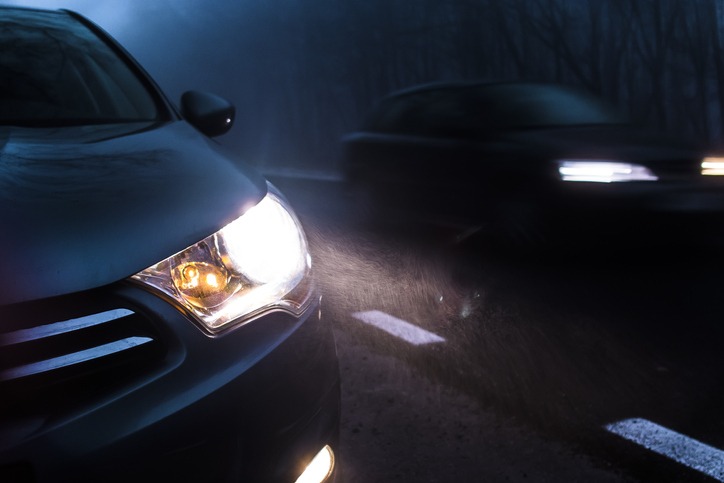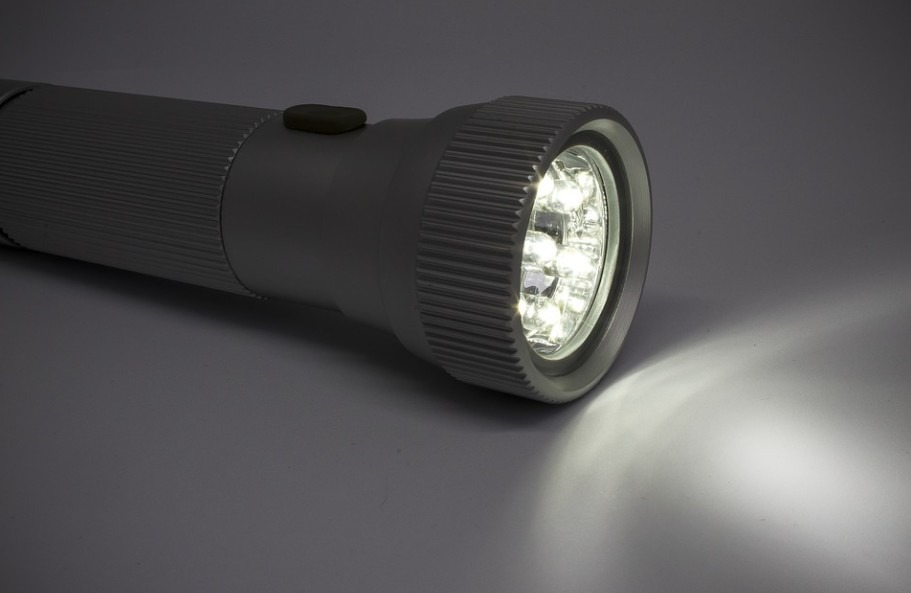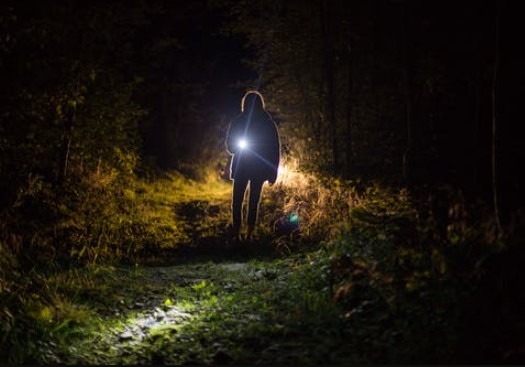Installing Motion-Sensor Lights for Added Security During Power Outages

Installing motion-sensor lights for added security during power outages is a practical step to protect your home. To ensure success, gather the necessary tools, adhere to safety precautions, and select optimal locations for installation.
Proper wiring and functionality can be challenging, but the benefits of enhanced visibility and deterrence are well worth the effort. Wondering about best practices to avoid false alarms or the most efficient placement strategies? Your home's safety during unexpected blackouts may depend on these considerations.
Tools and Materials

When setting up motion-sensing lights during power outages, you'll need essential tools like a screwdriver, wire stripper/cutter, and a voltage tester. These tools are crucial for managing electrical wires and ensuring a proper installation. You'll also need materials such as the motion-sensing light fixture, extra electrical wires, wire nuts, and a junction box.
Outdoor motion sensor lights can significantly improve your home's security during power outages by providing illumination and deterring potential trespassers. To set up the outdoor motion sensor, start by gathering all your tools and materials. If you're mounting the light high up, ensure you have a sturdy ladder.
First, assemble the light fixture according to the manufacturer's instructions. Use your wire stripper/cutter to prepare the electrical wires. Connect the wires from the light fixture to the existing electrical wires in your junction box, securing them with wire nuts. Use your voltage tester to verify there's no electricity flowing through the wires, ensuring a safe installation.
Safety Precautions
Before installing motion-sensor lights, ensure the power is turned off to prevent accidents. Start by switching off the breaker that controls the area where you'll be working. Use a voltage tester to confirm the power is completely off, as this crucial step helps you avoid the risk of electric shock.
Wear appropriate safety gear, such as gloves and goggles, to protect yourself from potential hazards like sharp edges or accidental electric contact. Always follow the manufacturer's instructions for the specific brand of motion-sensor lights you're installing, as each model may have unique requirements for a safe and effective setup.
If you're not confident in your electrical skills, seek professional help. An electrician can assist you in installing motion-sensor lights correctly, ensuring compliance with local regulations and safety standards. This step is essential for preventing accidents and ensuring your installation meets all legal requirements.
Improper handling of electrical installations can lead to dangerous situations. By taking these precautions, you protect yourself and your home, ensuring your new lights work flawlessly.
Installation Steps
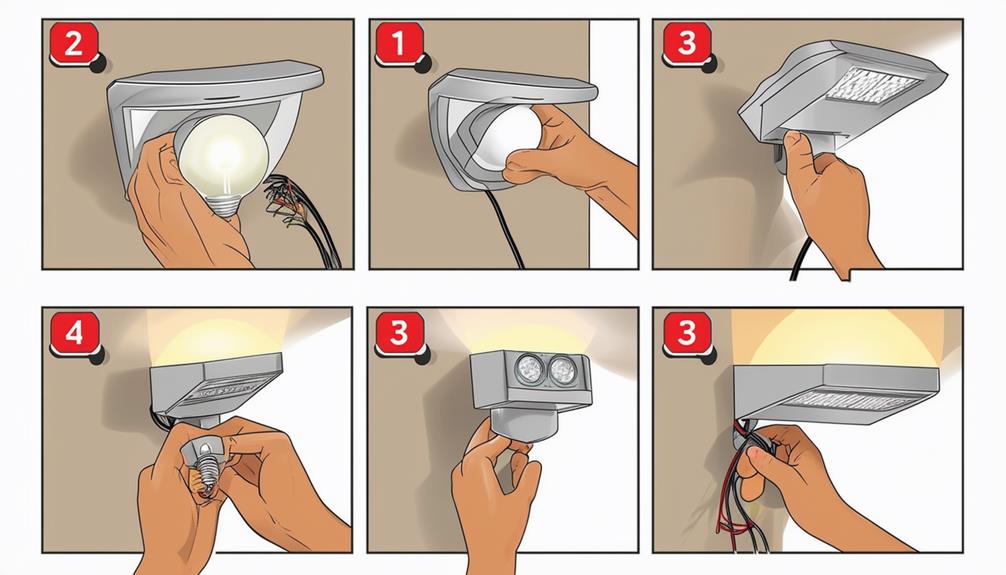
After confirming all safety measures are in place, gather your tools and materials for installing the motion-sensor lights. You'll need a screwdriver, batteries for backup power, and the motion-sensor light unit. These lights enhance security by providing reliable motion detection, even during power outages.
Here are the installation steps:
- Mount the Fixture: Choose a location in the dim areas where you need security the most. Use the screwdriver to mount the light fixture securely to the wall or ceiling. Ensure it's stable and positioned correctly.
- Insert Batteries: Open the battery compartment and insert the required batteries to ensure the light has backup power during power outages. This step is crucial for the motion-sensor lights to operate independently of the mains electricity.
- Test the Motion Detection: Once installed, test the motion-sensor lights by walking in front of them. They should automatically turn on, confirming that the motion detection is functioning properly.
Installing motion-sensor lights is a straightforward process that significantly improves security. By illuminating dark areas during power outages, you can rest easy knowing your home is protected. Follow these steps closely to ensure a smooth installation and enjoy the added peace of mind.
Placement Tips
Are you considering where to place motion-sensor lights for optimal security during power outages? Begin by installing them near key entry points such as doors and windows, which are common targets for intruders. Placing lights in these areas will significantly enhance your home's security.
Next, focus on illuminating dark areas like driveways and pathways. Proper lighting in these spots not only prevents accidents but also deters potential intruders during outages.
Strategic positioning is crucial. Ensure your motion-sensor lights cover a wide area for maximum visibility and safety. Consider the angles and distances to optimize coverage and avoid blind spots that could compromise your home's security.
Additionally, choose lights with backup power options such as battery or solar. These options ensure your lights remain functional even when the electricity is out, providing continuous security. Place these lights where they can easily access sunlight or be conveniently maintained for battery replacements.
Preventing False Alarms
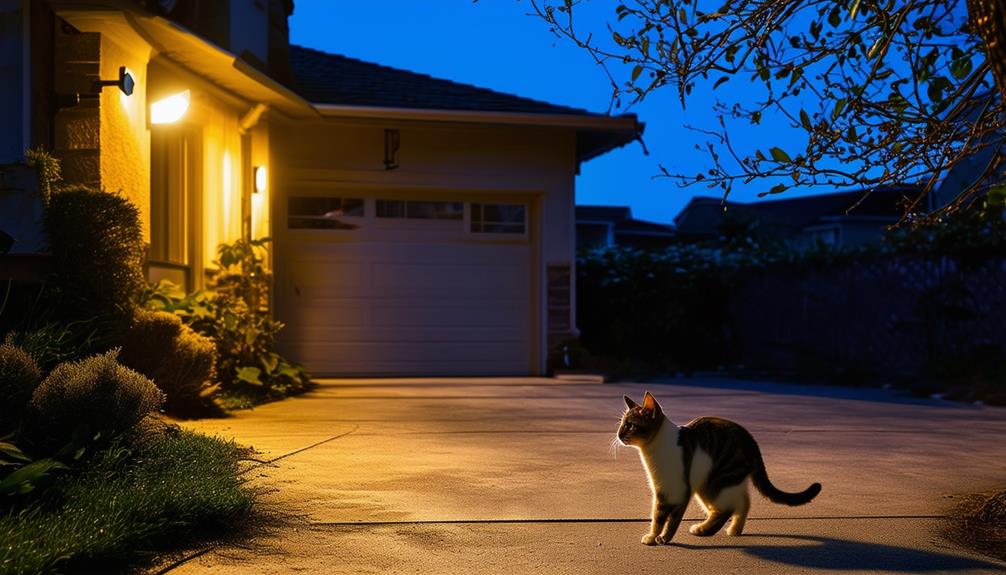
To decrease false alerts, adjust the motion sensor's sensitivity settings to ignore small animals or passing vehicles. Proper sensitivity calibration ensures that your security lights only activate when truly necessary, enhancing their reliability.
Consider the height and angle at which you position the motion sensor. Placing the sensor too low can lead to triggers caused by small animals, while an improper angle might detect non-threatening movements like swaying branches or passing vehicles. Aim for a height that minimizes false alerts but still effectively covers the intended area.
Here are three practical steps to further decrease false alerts:
- Masking Tape: Use masking tape to block off sections of the sensor's field of view. This helps prevent the sensor from detecting movement in areas where false alerts commonly occur.
- Clean Sensor Lens: Regularly clean the sensor lens to maintain peak detection capabilities and reduce the chances of false alerts.
- Dual-Technology Sensor: Upgrade to a dual-technology sensor that uses both infrared and microwave detection for more precise triggering. This combination reduces false alerts and ensures your lights activate only for genuine threats.
Conclusion
By installing motion-sensor lights, you enhance your home's security, particularly during power outages. With the right tools and careful installation, these lights can effectively deter intruders and improve visibility.
Proper placement and thorough testing are crucial, along with having reliable backup power options. Follow these steps, and you'll have peace of mind knowing your home remains well-lit and secure, even when the power fails.


